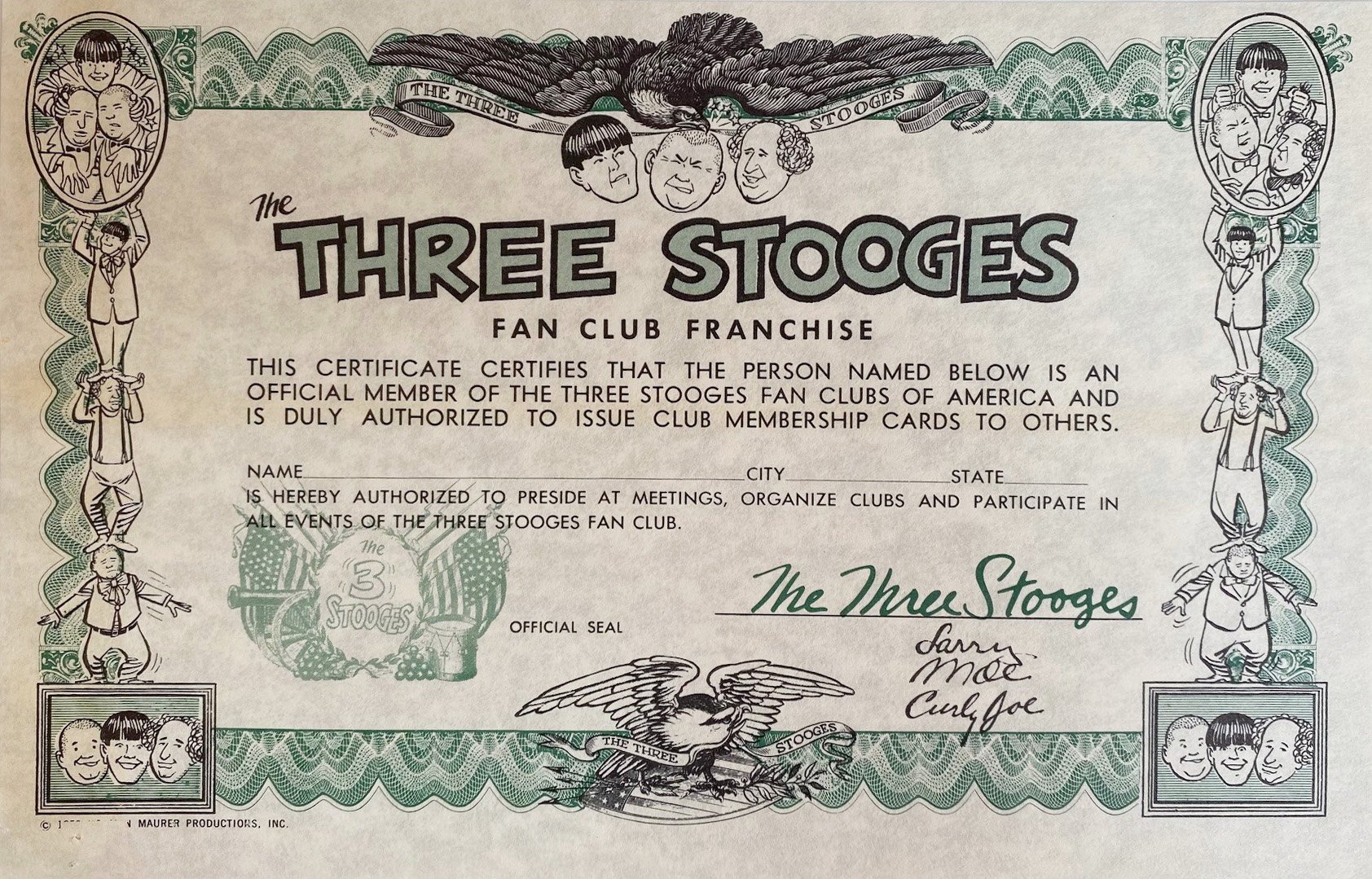Recently, in Find of the Week, For the Record, featured unexpected items found in Municipal Archives collections. The article described several objects stored in a box labeled “Department of Parks & Recreation – Artifacts,” including an “Official Three Stooges Fan Club” franchise certificate from 1960. At that time, the comedy trio, whose act dated back to the 1920s, were enjoying a resurgence in popularity with television audiences. However, that does not explain why their Fan Club kit would be filed with Parks Department correspondence.
Certificate from an Official Three Stooges Fan Club kit, 1960. Department of Parks & Recreation Collection, NYC Municipal Archives.
This week, For the Record, answers the question. As noted in the earlier article, when archival collections are processed, standard practice dictates that photographs, other non-paper materials, and oversize items are physically separated and stored separately. For example, photographic prints and negatives must be housed in acid-free sleeves and placed in special climate-controlled conditions. Three-dimensional objects are similarly removed from the paper files and re-housed in non-damaging containers and environments.
Certificate from an Official Three Stooges Fan Club kit, 1960. Department of Parks & Recreation Collection, NYC Municipal Archives.
The procedure further directs that the processing archivist fills-out a “Separation Sheet,” and substitutes it for the removed item. The sheet is a form that records the original location of the removed item, the name of the collection, a brief description, the location where the now-separated item is stored, the date when separated, and the name of the processing archivist. A copy of the separation sheet is also appended to the removed item.
Examining separation sheets attached to objects in the Parks Department artifact box provided the necessary information to identify the related correspondence files. The sheet appended to the Three Stooges Fan Club kit indicated that it had been removed from the Department of Parks General Files, sub-series, Queens – Concessions, 1960, folder no. 1.
Welcome letter from an Official Three Stooges Fan Club kit, 1960. Department of Parks & Recreation Collection, NYC Municipal Archives.
The contents of folder no. 1, answers our query. In a letter to Parks Commissioner Newbold Morris, dated July 20, 1960, Mr. John McKnight, Director of Aquarama, requested permission to distribute Three Stooges Fan Club kits “during their engagement at the Amphitheatre [in Flushing Meadow Park].” Mr. McKnight appended a sample fan club kit to the letter and concluded by inviting the Commissioner to see the Three Stooges “in person.” The correspondence did not include a copy of the reply and it is not known whether the Commissioner accepted Mr. McKnight’s invitation to see the performance, but Morris (or his correspondence secretary) dutifully filed the letter and fan club kit.
Letter from John McKnight to Parks Commissioner Newbold Morris, 1960. Department of Parks & Recreation Collection, NYC Municipal Archives.
The ‘back-story’ for other objects in the Parks artifacts box has also been traced. Among the larger items in the box are two flags, one labeled “Cuban Flag,” and the second, “Triangular Pennant with Rosette.” The related correspondence, a memorandum from R. C. Jenkins, Parks Department [Manhattan] Borough Director, to his superior, S. M. White, tells the story.
Cuban flag found in Central Park after a clash between pro-Castro and anti-Castro demonstrators, 1960. Department of Parks & Recreation Collection, NYC Municipal Archives.
Anti-Castro flag found in Central Park after a clash between pro-Castro and anti-Castro demonstrators, 1960. Department of Parks & Recreation Collection, NYC Municipal Archives.
The memorandum is dated January 29, 1960; subject: San Marti Monument – Riot – January 28, 1960. According to Jenkins, “At about 3 p.m. [the previous day], two organized groups consisting of approximately 100 persons converged at 59th Street and the Avenue of the Americas’ entrance to Central Park, near the base of the San Marti Statue. One group was pro-Castro and the other anti-Castro.” Jenkins continued, “. . . it is apparent that one group was intent on putting a wreath at the fenced-in base of the San Marti Statue and that the other group . . . tried to prevent it.” He added, “This started a fight, which police very quickly broke up and then dispersed the groups. It would seem as though the police were forewarned as to what might happen.” Jenkins concluded by noting that “Park personnel picked up two flags, which were left laying on the ground. I am sending these two flags with this report.” The memorandum also included a hand-written note “White Rose – Anti-Castro.” As with the Stooges kit, the folded flags were filed with the correspondence.
Memo from R. C. Jenkins, Parks Department [Manhattan] Borough Director, to his superior, S. M. White, 1960. Department of Parks & Recreation Collection, NYC Municipal Archives.
The New York Times article, “Central Park Ceremony for Cuban Hero Erupts Into Riot Over Castro,” which ran the following day, January 29, 1960, provided further details. According to the Times, one month earlier, a pro-Castro group had been denied a permit to hold a birthday celebration at the Marti statue. They subsequently learned that an anti-Castro group, the White Rose Organization would be allowed to place a wreath at the statue at 3 p.m. on January 28. The Times reported that “At 2:55 p.m. about forty members of the White Rose Organization, led by five teenage girls carrying a wreath of white roses reached the corner. Groups of loiterers, who later identified themselves as members of the Twenty-sixth of July Movement, converged upon the marchers, tore the wreath from the girls’ hand and use it as a weapon.” The resulting melee resulted in several injuries and twelve arrests, six from each side. The newspaper story added the detail that the “police commandeered a bus, evicted four passengers and transported the beleaguered group to Ninetieth Street and Fifth Avenue.”
Look for future For the Record articles that feature items found in Municipal Archives collections—both expected and unexpected.



